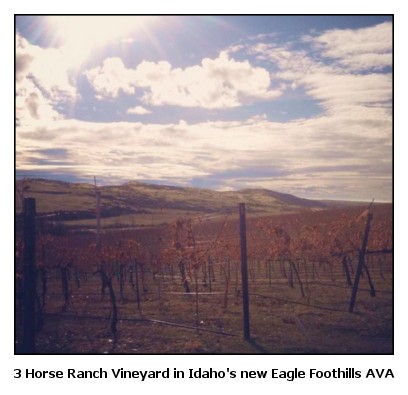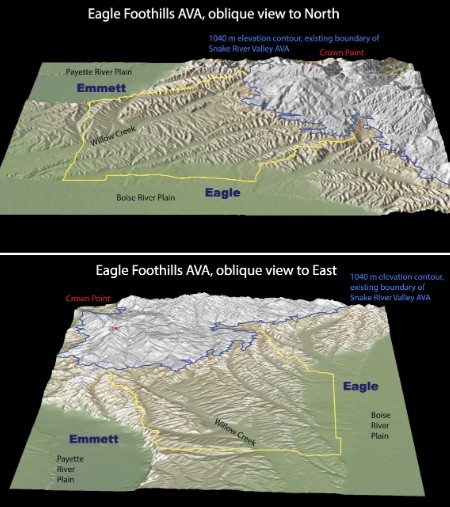Eagle Foothills AVA...
Idaho's 2nd AVA - Snake River Valley's 1st Sub AVA
Go to main Idaho Wine Country page
Go to Snake River Valley Overview Maps
Go to Lewis-Clark Valley Wine
Country page
Place matters, say growers
from around the world… and from Eagle, Idaho as well.
In November of 2015, the
wine community around Eagle learned their petition was successful in
gaining American Viticultural Area (AVA)**
status for a second Idaho AVA. The Eagle Foothills winegrowing area has been granted AVA
status of its own, distinct from the larger Snake River Valley AVA that
surrounds it.
AVA. The Eagle Foothills winegrowing area has been granted AVA
status of its own, distinct from the larger Snake River Valley AVA that
surrounds it.
Idaho’s new Eagle Foothills
AVA lies entirely within the Snake River Valley AVA, making it the Snake
River Valley’s first sub-AVA and Idaho's second AVA. The encompassing
Snake River Valley AVA has boundaries that spread across two states,
Idaho and Oregon; although most of the Snake River Valley's area lies
within southwestern Idaho, it does cross into eastern Oregon. The Eagle
Foothills AVA, on the other hand, lies completely within Idaho State
boundaries.
The new AVA’s area
encompasses nearly 50,000 acres of land north of Eagle, near Idaho’s
capital city, Boise. The influence of nearby Prospect Peak at 4,874
feet elevation contributes to the unique terroir
of the Eagle Foothills AVA; the drainage flow of the air from the hills
in the area around it creates a unique
 climate. The soil of the
new AVA also differs from other areas of the Snake River Valley AVA,
featuring granite pebbles mixed with volcanic ash/sandy loam resulting
from Ancient Lake Idaho. Nearly 70 vineyard acres are currently
planted (as of November 2015), with plans for more than 450 planted
acres in the near future. climate. The soil of the
new AVA also differs from other areas of the Snake River Valley AVA,
featuring granite pebbles mixed with volcanic ash/sandy loam resulting
from Ancient Lake Idaho. Nearly 70 vineyard acres are currently
planted (as of November 2015), with plans for more than 450 planted
acres in the near future.
Unique Elements of
Eagle Foothills
Discussion about the Eagle
Foothills’ unique terroir began in 2012 when Martha Cunningham, co-owner
of 3 Horse Ranch Vineyards (currently the only winery in the Eagle
Foothills AVA **) asked for help from two
scientists to evaluate the terroir of the Eagle Foothills area.
For quite some time, she and her husband Gary Cunningham had realized
they lived in and were growing grapes in a special microclimate. Both
Dr. Gregory Jones, a renowned climatologist and professor of
environmental science at Southern Oregon University, and Dr. Clyde Northrup, professor of geosciences at Boise State University, agreed the Eagle Foothills area — its
climate, soil and terrain — is different from the rest of the Snake
River Valley, or any other growing area.
After reading Greg Jones'
report, Cunningham concluded "This needs to be done. Establishing the Eagle
Foothills AVA will help further position Idaho as a developing wine
region and hopefully attract growers, wineries, tourism and jobs.”
Using the federal
government's TTB petition process, Cunningham made the
push to identify and authenticate the new Viticultural Area. In
November of 2015, she was rewarded for her efforts when AVA status was
granted to the Eagle Foothills. She hopes other areas of the
Snake River Valley AVA will move ahead to craft petitions for their own
unique spots. "The Sunnyslope deserves its own AVA, too," says
Cunningham. "The Snake River Valley is so vast, and certainly
diverse enough, I see no reason for others not to follow."
3 Horse Ranch Vineyards
(Wed
- Sun, 12 - 6pm. Closed Mon & Tues)
5900 Pearl Road
Eagle, ID 83616
208-863-6561
***
Visitors to the Eagle, Idaho area can taste the wines of 3 Horse
Ranch Vineyards and one other
Idaho winery on Saturdays at the Eagle Art Gallery (50 2nd Street N,
Eagle, ID)
where Cellar 616 Winery conducts tastings from 11 am - 4 pm or by
appointment (208-906-9590).
More details
about Eagle Foothills AVA
Unique elements of the Eagle Foothills AVA include:
SOIL
– Soils consist of sand from volcanic ash, silt, granite pebbles and
clay that are well drained and rich in mineral grains because of the
sedimentary bedrock from ancient Lake Idaho and the nearby granitic
mountains.
CLIMATE –
The hills form
south facing slopes creating hot afternoons and evening shade. The
cool temperatures, short growing season and low growing-degree days
allow for successful ripening of early to mid-season grape
varieties, with low acidity levels. The precipitation varies between
11-18 inches per year and averages 2,418 growing days annually.
WATER –
Water is
abundant, despite the desert terrain of the Eagle Foothills. The AVA
is located near the Snake River aquifer—one of the most productive
water sources in America. The proximity to water gives Idaho
potential to have sustainable vineyards for generations to come.
The Eagle Foothills
sits at the north bank of Ancient Lake Idaho, its elevation ranging
from 2,490 to 3,412 ft.
**
An AVA is a federally
designated wine grape-growing region distinguishable by distinct
geographic features such as climate, soil, elevation and physical
features.
|